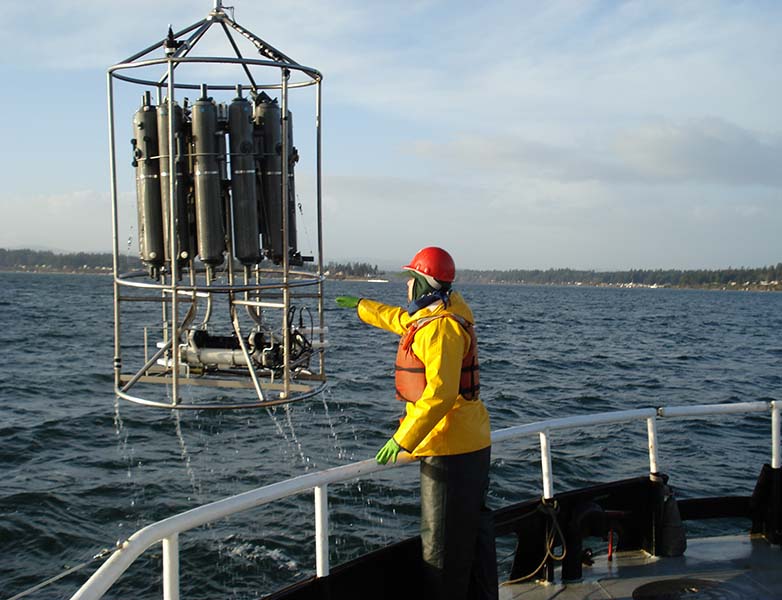
Climate and Communities scenario presented; workshops to follow
The Council endorsed the Climate and Communities Core Team’s) final climate scenario document in September.
The Council has been conducting a climate change scenario planning exercise for over a year as part of the Fishery Ecosystem Plan Climate and Communities Initiative. At a January workshop that included a broad array of stakeholders, the CCCT developed four scenarios, describing oceanographic, social, and ecological conditions in the California Current Ecosystem 20 years into the future.
The Council endorsed the Ecosystem Advisory Subpanel recommendation that the document include a stand-alone preface describing the background and intent of the scenario planning exercise.
The next stage of the exercise will involve a series of workshops exploring the implications and actions that could follow from the scenarios. The scenario descriptions will be the primary source material for these workshops. The Council recommended conducting these workshops online over the coming months, while recognizing the limitations of online meetings. A final report on workshop outcomes is planned for March 2021.
Habitat Report
Habitat factors in salmon rebuilding plans
The Habitat Committee (HC) has been reviewing habitat-related factors that contributed to the overfishing status of Sacramento River fall Chinook and Klamath fall Chinook. Working with the Science Centers and Salmon Technical Team (STT), the HC identified 27 indicators that help explain impacts to each salmon life stage between 2012 and 2020 for Sacramento River fall Chinook. Each indicator will be ranked using a stoplight approach (poor, average, good) for its level of contribution to the life stage impact. The HC will continue this work, and plans to develop a similar approach for Klamath River fall Chinook.
Finfish aquaculture in California
The HC continues to track aquaculture permitting off San Diego. In September, NOAA issued a Notice of Intent to prepare a draft environmental impact statement for finfish aquaculture in Federal waters off the coast of San Diego by Pacific Ocean Aquafarms (formerly Rose Canyon Fisheries). A site off of Long Beach is also under consideration for the project. Public hearings are scheduled for October 14 and 16, and the comment period closes October 26. Learn about how to participate here.
U.S. Fish and Wildlife proposes changing critical habitat regulations
The U.S. Fish and Wildlife Service (USFWS) is proposing to amend their regulations related to designating critical habitat under the Endangered Species Act (ESA). The ESA makes it clear that biological considerations drive the initial step of identifying critical habitat, but it also allows the Secretary of the Interior to exclude any area from a critical habitat designation if the benefits of exclusion outweigh the benefits of inclusion, so long as excluding it will not result in the extinction of a species.
This proposed rule provides a framework for how the USFWS would consider the economic, national security, and other relevant impacts when designating critical habitat.
Previously, Federal lands were not typically excluded from critical habitat designations; this proposal reverses that position, and identifies avoiding administrative costs as a benefit of exclusion. It also establishes a policy that when the benefits of exclusion outweigh benefits of inclusion, those areas shall be excluded (rather than may be excluded, which is the default position).
Federal Energy Regulatory Commission requirement shakes up Klamath dam removal process
The Federal Energy Regulatory Commission (FERC) is requiring PacifiCorp (the owner/licensee of the four lower Klamath Dams) to remain a “co-licensee” of the dams as they are removed. In response, PacifiCorp has indicated that removing the dams will require more negotiations beyond the Klamath Hydropower Settlement Agreement.
Discussions between the Klamath River Renewal Corporation, PacifiCorp, and others around liability and indemnification are underway.
Feds propose cuts to Central Valley Project Improvement Act Restoration Fund
The Bureau of Reclamation is proposing sweeping changes to the Central Valley Project Improvement Act Restoration Fund. In particular, Reclamation proposes at least a $10 million/year reduction in the fund, which would have far-reaching impacts to Central Valley fish habitat and Council-managed stocks, and could reduce Reclamation’s ability to achieve its restoration goals.
Reclamation is currently evaluating its options. There may be an opportunity for Council comment in the future.
California proposes revised Delta Tunnel plan
The State of California is proposing a revised Delta tunnel project with intakes below Sacramento. California is looking at various configuration options, including a new pumping facility or conveyance of water to existing pumps.
The project would move between 3000 and 7500 cubic feet per second (cfs) of water. For comparison, the April flushing flows for the Klamath River this year were 6000 cfs. The project is likely to significantly reduce water quality above the Sacramento-San Joaquin Delta, which is important migratory and rearing habitat for Sacramento River salmon. The Army Corps of Engineers is conducting a National Environmental Policy Act analysis for the proposed project. Comments are due October 20; see this page for information on how to comment. The Council will be sending a comment letter that will be posted on the Council website by the end of October.